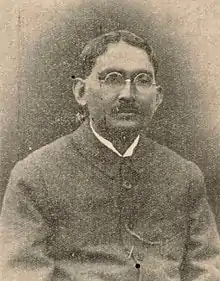Nil Ratan Dhar | |
|---|---|
 | |
| Born | 2 January 1892 Jolkhada, British India (now Jessore, Bangladesh) |
| Died | 5 December 1986 (aged 94) |
| Nationality | British India, India |
| Alma mater | |
| Known for |
|
| Relatives |
|
| Awards |
|
| Scientific career | |
| Fields | Physical Chemistry, Soil Science |
| Institutions | University of Allahabad |
Nil Ratan Dhar FNA, FRSC (2 January 1892 – 5 December 1986) was an Indian professor of soil science and chemistry at the University of Allahabad, known for discovering thermal and photo-chemical fixation of atmospheric nitrogen in the soil.[1] He was the brother of a freedom fighter Jiban Ratan Dhar. He was known as the "father of Indian physical chemistry."[2][3][4] Dhar was a founding member of many scientific organizations like The World Academy of Sciences,[5] the National Academy of Sciences, India and the Sheila Dhar Institute of Soil Science, Allahabad.
Early life and education
He was born on 2 January 1892 in Jolkhada, British India (now Jessore, Bangladesh) to Prassana Kumar Dhar, a lawyer, his grandfather, Prem Chand Dhar, was a Zamindar of the place. and his mother Nirode Mohini Dhar, the daughter of a local zamindar.
He obtained his DSc from University of London in 1917. In 1919, he earned a doctorate of science in France. He was awarded honorary DCs from Banaras Hindu University, University of Allahabad, Jadavpur University, Gorakhpur University and Visva-Bharati University.
Awards and memberships
Dhar was elected a fellow of the Chemical Society of London (FCS) and the Institute of Chemistry (later the Royal Institute of Chemistry) in 1919.[1][n 1] In 1935, he was appointed a Foundation Fellow of the National Institute of Sciences of India (FNI, now the Indian National Science Academy.[6][n 2] Dhar was a corresponding member of the Academy of Sciences, France and a foreign member of the French Academy of Agriculture. He was nominated for the Nobel prize four times. He was also a founding member of the Indian Chemical Society and the National Academy of Sciences, India, and the president of both organizations from 1933 to 1934 and 1935–1937 respectively. Though not a founding member, he also served as the president of the Indian Society of Soil Sciences. Dhar was also a member of the Society of Biological Chemists, India. In 1961, he became the General President of the Indian Science Congress Association.
Notes
- ↑ Both institutions merged in 1980 as part of the formation of the Royal Society of Chemistry (RSC); the post-nominal became "FRSC" from that time.
- ↑ Prior to 1970, the Indian National Science Academy was named the "National Institute of Sciences of India", and its fellows bore the post-nominal "FNI". The post-nominal became "FNA" in 1970 when the association adopted its present name.
References
- 1 2 Misra, S. G. (1986). "Nil Ratan Dhar (1892–1986)" (PDF). Biographical Memoirs of Fellows of the Indian National Science Academy. 14: 1–53.
- ↑ "INSA :: Deceased Fellow Detail". www.insaindia.res.in. Retrieved 5 July 2022.
- ↑ "Chemistry Tree - Nil Ratan Dhar". academictree.org. Retrieved 5 July 2022.
- ↑ S; B, eep; hu (29 October 2018). "GOPAL KRISHNA PURANIKThe Life and Works of Gopal Krishna Puranik". GOPAL KRISHNA PURANIK. Retrieved 5 July 2022.
- ↑ "Dhar, Nil Ratan". TWAS. Retrieved 5 July 2022.
- ↑ "National Institute of Sciences of India: List of Foundation Fellows" (PDF). Indian National Science Academy. 1935. Retrieved 28 July 2023.